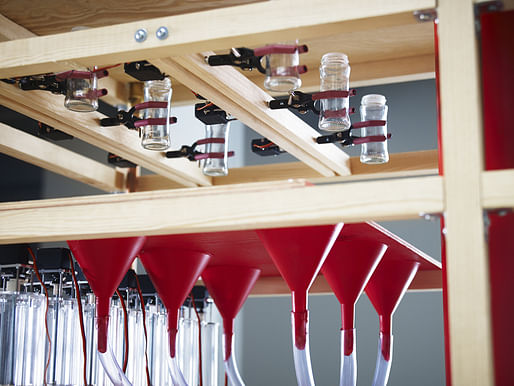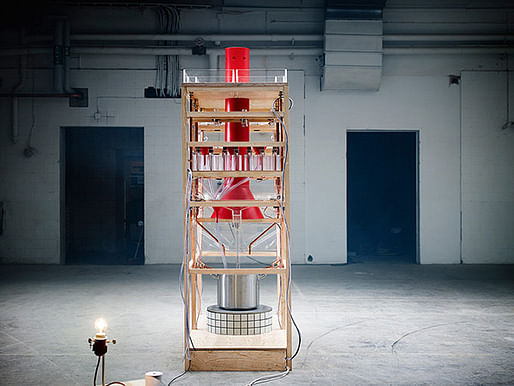
For some meals, it's not the food that makes it special, but how it was prepared. A cake made by a dear friend can taste better than the one bought from the bakery; instant oatmeal becomes transcendent made over a campfire in the woods. The traditions of cooking that we abide by are part economical, part chemical science, part sorcery — what comes out the other end is an alchemy.
"Play with Your Food", the AA Visiting School being held this summer in San Juan, Puerto Rico, wants to investigate that alchemical process from an architectural perspective. What can the design process of architecture learn from the designed process of cooking and mixology? One experimental approach to this way of thinking comes by way of the "Food Machine", an automated kitchen device cooked up by a group of Swedish designers. Petter Johansson, Christian Isberg, Lasse Korsgaard and Carl Berglöf created an open-source cooking device, that can be accessed by multiple people at once from anywhere in the world. Participants collaboratively determine the inputs into the machine, and then the machine composes their collective dish from a preset collection of ingredients.

The Machine offers a fresh look at interactivity and online identity within the context of collaborative food production — whether it can still be called "cooking" is up to debate. The project may spit out something edible, but it implicates a larger future of human-machine interaction and food as a space for human socialization. Like architecture, the Food Machine is a designed stage for human performance. Co-creator Christian Isberg contributed some additional thoughts on how the Food Machine has shifted his own experience with food and cooking, and the iterative design parallels between food and architecture.
Has the Food Machine changed your perception of everyday cooking?
Hmm, I think there are several answers to this question — all of them relates to various contexts. Such in everyday life, I still boil my pasta, buy my own vegetables and stir the pot with the power of my arm. This is something I’m forced to do, else the mechanisms of the body won’t work. I need to boil the pasta and I need to eat everyday. So in that way, no.
Then, on another hand, yes. Cooking is a great context for collaborations, there’s always several experts who always do the cooking in their own way, regardless if it’s about chopping carrots or tempering the water. You talk, drink, cook, eat and drink. It’s a joyful time, but the eat and drink moment is also the end of it, perhaps you tell your friends on Monday what you did when they asked about the weekend. It’s very pre-programmed.

So what I think is that the machine itself didn’t change the perception of everyday cooking — we all have electric motors in our kitchen that facilitate cooking. But when looking at the whole project, Collaborative Cooking, I would say yes. The machine itself is only a tool, a transportation. The way I see it is that it changed the way I look at the dialogue when cooking, suddenly you start wonder how other people think, why did s/he decide to to that, can’t they see that I have the perfect boeuf boef bourguignon coming up. It allows for errors and play, they are part of the process.

Describe a significant, early moment you had with food or cooking — your Proustian madeleine experience.
I was raised on pizza, so I have quite some memories from my ham & cheese pizzas bought in the suburb of Stockholm. But before I moved to Amsterdam to study I had the idea of becoming a chef, or at least exploring it more. I had (and still have) a big fascination of separate ingredients being put together to create a new whole. It’s like separate entities becomes one entity. You can't (or at least I can't) imagine the outcome of mixing two ingredients together. It’s an organic process which sometimes gives birth to something beautiful, not visually speaking. I think it goes hand in hand with any other project I do, to gain knowledge about how things work or don't work together, the freedom of exploring which often can lead to something beautiful which is born out of the process. It doesn’t mean that the food needs to taste, smell or look good; it’s the process as a whole that makes it beautiful.

In your opinion, how are cooking and architecture related?
I think the consumption of both of them, both are available for us in various types and we have individual tastes. Taste, which is constantly being affected. I constantly try to break my patterns, yet to realize that almost all time I end up in the same. I think that certain things are expected by certain architectures, and the same goes for food. It has to do with our senses — what is right and what is wrong according to us.
I think it’s more interesting to think of how if was before it became a dish, before the building got covered with glass walls. That's the point when you can start to deconstruct, reinterpret, analyze and replace parts, to create your own structure within the structure, your own relations. As I/we do this, we replace parts trying to find new meanings; which often makes me realize that there’s no unified truth, only infinite interpretations.
— Christian Isberg

"Play With Your Food" will take place in coordination with the Universidad de Puerto Rico, Escuela de Arquitectura in San Juan, from Monday June 30 through Friday, July 11.
Applications are open until today, June 27. For more details regarding fees, eligibility, and how to apply, click here.
No Comments
Block this user
Are you sure you want to block this user and hide all related comments throughout the site?
Archinect
This is your first comment on Archinect. Your comment will be visible once approved.